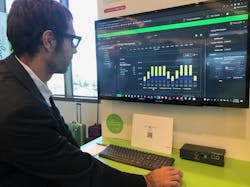From Elephants to EcoStruxure: Building Remedies to understand the Facility Energy Footprint
LAS VEGAS--Energy is the proverbial elephant in the room. A mass-consuming, mass-emitting elephant, if you can pardon the image.
The residential, commercial and industrial buildings segment combined is the pachyderm of power consumption, or the true king of the jungle of air pollution. Together they account for close to 40 percent of U.S. energy consumption and close to that portion in greenhouse gas emissions.
Tame that segment and the Path to Net Zero becomes more of a walk in the park then a struggle in the jungle. In other words, tackle the low-hanging fruit first.
“Until you see how much you consume, you don’t have a trigger to move into action,” Sophie Borgne, senior vice president of digital power at Schneider Electric, said last week in an exclusive interview with EnergyTech at her company’s Innovation Summit in Las Vegas.
Read more from the Schneider Electric Innovation Summit
Energy efficiency technologies rank low on the sexy meter for decarbonization headlines, but the quiet ones are often the strongest. The International Energy Administration has estimated that energy efficiency accounts for only about 14 percent of trillions invested in energy, but the capital commitment is deep across numerous major companies.
Schneider Electric, for instance, was touting its upgraded Ecostruxure Energy Hub cloud-based system aimed, for a start, at small commercial buildings, schools and other mid-size facilities. ABB recently acquired the NEMA motors business from Siemens, giving it an even stronger hold in the line of motors and drives used in buildings’ HVAC and energy management work.
The EcoStruxure Energy Hub offers a network for smaller building owners and operators to track energy use floor by floor, equipment by equipment (HVAC, lighting, etc). It can focus on energy intensity, such as kWh per square meter or foot and, factoring in energy rates, help a customer determine financial next steps.
“You can save 20 to 30 percent on energy use” by gaining that in-depth understanding in where and how the building is energized, lighted and heated or cooled,” Borgne pointed out. You can also calculate the return on investment of buying more efficient technology.
ABB Electrification, another longtime energy technology giant, is working to provide deeper energy efficiency solutions both on the physical front, such as motors and drives, but also the software and digital side, partnering with BrainBoxAI on artificial intelligence-gained insights into the factors of facility energy use. ABB and BrainBoxAI also teamed up on a recent webinar with EnergyTech titled “Energy Efficiency means (Good) Business: How Technology can Save Time, Save Money and Save the Plant.”
The reason for highlighting product offerings on the building energy usage front is, as always, following the demand and direction of markets.
“Ninety-six percent of our customers in the U.S. are investing in energy efficiency,” Jesse Henson, president of NEMA Motors-ABB, said earlier this year in an EnergyTech interview.
Schneider Electric believes that the platform offered via EcoStruxure Energy Hub could be a cloud-based game changer for a segment of business often lost amidst the industrial giants and commercial chains. The point of entry could be schools and smaller retail outlets, facility managers and real estate management firms, Borgne said.
EcoStruxure Energy Hub takes only two hours or less to set up, wherever the building’s meters are located. It sends the recurring energy consumption and intensity info into the data hub, where those customers can access it 24 hours a day for an updated snapshot into their facility.
Schneider Electric has run the program through a project with the University of Denver, which utilized the EcoStruxure hub technology on its heavy laboratories and moved to other buildings to compare and contrast and, eventually, figure where they can gain greater control or make smart investments in energy efficiency.
“They could benchmark that energy use to similar buildings,” Borgne said.
The incentives and credits afforded by the recently signed Inflation Reduction Act will help spur billions of dollars more in greater investment in energy efficiency. On the HVAC front—where the biggest room for improvement is—the U.S. Department of Energy is driving manufacturers, such as Lennox, to come up with next-gen and cold-climate heat pumps which are purely electric and can help homes and businesses avoid the need for natural gas heating.
Schneider Electric and EnergySage recently participated in another EnergyTech webinar on the future impacts and road map of the Inflation Reduction Act. Click here to register for that session on demand.
-- -- --
(Rod Walton, senior editor for EnergyTech, is a 14-year veteran of covering the energy industry both as a newspaper and trade journalist. He can be reached at [email protected]).
Follow us on Twitter @EnergyTechNews_ and @rodwaltonelp and on LinkedIn






